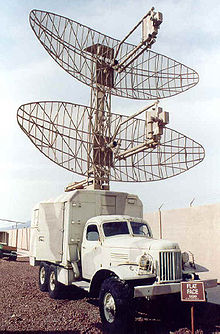|
P-15 radar
The P-15 "Tropa" (Russian: "Тропа"; English: "trail") or 1RL13 (also referred to by the NATO reporting name "Flat Face A" in the west) is a 2D UHF radar developed and operated by the former Soviet Union. DevelopmentIn 1952 SRI-244 started development of what become the P-15 early warning radar; by 1955, the radar had passed state trials and was accepted into service with the anti-aircraft troops of the Soviet armed forces.[1] The P-15 was designed to detect aircraft flying at low altitude and came to be associated with the S-125 "Neva" anti-aircraft system (NATO reporting name SA-3 "Goa"), though it was later replaced by the P-15M2 "Squat Eye" radar which mounted a single radar antenna on a 20-30 meter mast to improve coverage.[2] In 1959, the modernised P-15M "trail" radar passed through the state test program, the modernisation replacing outdated mercury-based electronics. In 1962, another modernisation of the P-15 passed through trials as the P-15N, the radar being developed and produced by the Ulyanovsk Mechanical Plant.[1] The P-15N introduced a more sensitive receiver, which improved the detection range and a new amplifier for the transmitter. Further improvements were made in 1970 when the P-15MN passed trials. The P-15MN included a pulse coherent Doppler filter (moving target indicator) to remove passive clutter (by up to 50 dB),[1] the first such radar in the Soviet Union.[3] Finally by 1974, the modernisation of the P-15 was so extensive that it resulted in a new designation, the P-19 "Danube", also known as the 1RL134. The P-19 is known in the west as the Flat Face B. Description The P-15 is a high mobility radar. With the antenna mounted directly on the single truck (Zil-157) used for transport, the system could be deployed and taken down in no more than 10 minutes.[4] The P-15 uses two open frame elliptical parabolic antenna accomplishing both transmission and reception, each antenna being fed by a single antenna feed.[5] The radar can rapidly shift its frequency to one of four pre-set frequencies to avoid active interference, with passive interference being removed by a coherent doppler filter.[1] Azimuth was determined by mechanical scanning with an associated accompanying PRV-11 (NATO reporting name "Side Net") used to determine elevation.[2] A secondary radar for IFF is generally used in conjunction with the P-15, generally the 1L22 "Parol".[5] Operators
See alsoExternal linksWikimedia Commons has media related to P-15. References
|
||||||||||||||||||||||||||
